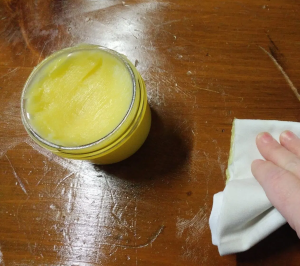Linseed Oil Recipes
How I use it
OK, the chemistry lesson is over. Boiled Linseed Oil (BLO from here on out) is pretty viscous and as noted above, by itself, not a good long term finish. So I use a blend of ⅓ BLO, ⅓ Varnish, ⅓ Mineral Spirits. This flows more easily and more quickly builds a nice sheen that's also more durable than BLO alone.
I generally make it a quart at a time. That first coat is rather generous as much of it will be absorbed into the wood's pores. Subsequent coats are ragged on and will dry in 6-8 hours making building a sufficient finish more tolerable to the impatient woodworker (me). Stuff I use around the shop gets 2 coats (allows you to easily scrape off glue and differentiates that piece of wood from scrap wood). Furniture that leaves the shop gets 4 coats, sometimes more if it will see high use. Even this isn't sufficient for something like a tabletop, that gets a top coat of polyurethane or lacquer.
Another Technique
I got this from makesomething.com, it's another technique for doing the same thing I outlined above. Captured here because the original link is already dead. His blend is exactly the same as mine except he uses polyurethane instead of varnish.
Prep
- Sand down to 220 grit and remove all machine marks.
- Using the maroon, grey, and white abrasive pads, finish sanding the project.
Apply
- Flood the surface with the oil/poly blend with a foam brush and immediately rub off any excess finish with a rag.
- Let the project sit for 10 minutes and come back with a fresh paper towel to wipe down all surfaces.
- After 24 hours repeat all the steps from day 1.
- Once again wait 24 hours and repeat all the steps from the previous day.
- After waiting another 24 hours apply the final coat with a rag and this time do not wipe it off.
- After waiting 24-48 hours for the project to dry, apply a coat of Briwax wax by rubbing it generously onto the surface and then buffing it in with a fresh paper towel or rag.
Add Wax
Another very common finish both on its own and in conjunction with linseed oil is beeswax. Rubbed into the surface of wood you get a nice finish, though not very durable. Applied over an oil finish, it looks even better and is the way we see it used later in period and into modern times.
Use
If you don't care about chemistry and just want to understand and use the finish, this part is for you.
Linseed oil isn't a film finish (like varnish or shellac), it soaks into the pores of the wood and drys. This accentuates the figure and grain of the wood but it isn't very protective. However, it's easy to repair, just recoat. To get a shinier finish, add more coats. To keep it shiny, add a coat (or more) of wax.
I usually start with a plain linseed oil coat and apply it liberally with a paintbrush. If by the time I finish coating a project, there are dry areas already, I coat that area again. Come back at least 30 minutes later, but it could be hours and wipe off any excess that remains. Allow it to dry overnight. If it's cool, it might take as many as two or three days to fully dry.
It looks pretty good already, doesn't it? Well, yes, but it doesn't have much of that sheen yet. So, you will want to add additional layers of oil. These additional layers will be thinner. You are building finish now, the wood won't be soaking up much more if any. So for subsequent coats, I apply it with a cloth and wipe on a layer then let it dry overnight (or longer).
There is an old adage that I believe is 18th Century:
- One coat a day for a week, one coat a week for a month, one coat a year forever.
Nice, eh? Well, it won't stay that way. Over time, the wood will dry out and start to look dull like it is covered in a fine layer of dust. To avoid that, you need to either add more layers of oil or some other finish on top to protect the oil layer. That's wax.
Once the oil has fully cured, apply wax. The commercial stuff or something you whip up yourself. Rub it in and be sure you get a nice even coat. Allow to dry and then buff off. Now, you're done. For now. The wax will also dry out over time, just slower. Again, really easy to renew it by adding a new coat.
Don't get too froggy here. Putting on 6 coats of wax is a waste of time. The paste includes solvents, for wax, so you are at best making a slightly thicker layer of wax. You can't really build layers like that.

